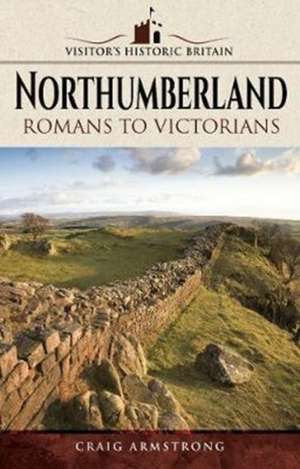Visitors' Historic Britain: Northumberland
Autor Craig Armstrongen Limba Engleză Paperback – 30 apr 2018
No other county in Britain has as many medieval remains as Northumberland. From the most grand such as Alnwick Castle (known as the Windsor of the North, the home of the Dukes of Northumberland, the capital of Northumberland, and, to many, Hogwarts ) to humble remains such as the Chantry at Morpeth. At Warkworth visitors can tour the medieval church (scene of a 12th century Scottish massacre), Warkworth Castle (another Percy possession and the setting for a scene in Shakespeare's Henry IV), a medieval hermitage, and the fortified bridge gatehouse (one of the only surviving examples in Britain).
Northumberland was ravaged during the Anglo-Scottish Wars and this led to the development of family clans of Border Reivers who were active during the 16th and early 17th centuries. Raiders, looters, blackmailers and courageous cavalrymen the Reivers have left many surviving remnants of their harsh time. Peel Towers dot the landscape alongside Bastle Houses. The active can even walk in the footsteps of the Reivers by following the Reivers Way long distance path.
Victorian Northumberland was dominated by both farming and, increasingly, by the industrial genius of some of its entrepreneurs. The greatest of these, Lord Armstrong (known as the Magician of the North), has left behind one of the most magnificent tourist sites in Britain; his home at Cragside. Carved from a bare hillside and transplanted with millions of trees and shrubs and crowned with the beautiful Cragside House visitors can walk the grounds taking advantage of various trails and spotting wildlife such as red squirrels before visiting the first house in the world to be lit by electricity
Preț: 83.18 lei
Nou
Puncte Express: 125
Preț estimativ în valută:
15.92€ • 17.30$ • 13.38£
15.92€ • 17.30$ • 13.38£
Carte disponibilă
Livrare economică 31 martie-14 aprilie
Livrare express 14-20 martie pentru 23.99 lei
Preluare comenzi: 021 569.72.76
Specificații
ISBN-13: 9781526702784
ISBN-10: 1526702789
Pagini: 152
Ilustrații: 30 illustrations and maps
Dimensiuni: 236 x 158 x 12 mm
Greutate: 0.34 kg
Editura: Pen & Sword Books Ltd
ISBN-10: 1526702789
Pagini: 152
Ilustrații: 30 illustrations and maps
Dimensiuni: 236 x 158 x 12 mm
Greutate: 0.34 kg
Editura: Pen & Sword Books Ltd
Descriere
From the building of Hadrian's Wall in 122AD to the first house in the world to be lit by electricity, Cragside House, Visitors' Historic Britain: Northumberland details the many castles and monuments - their remains and grounds - and the stories they each tell.
